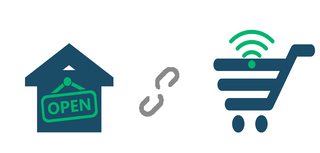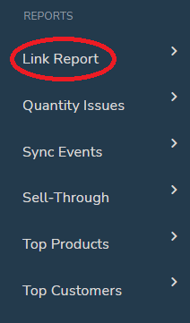This article talks about how the Link Report works and how you can use it to link your products together so your stock counts are unified and syncing between your Point of Sale and your eCommerce platforms.
Quick Navigation Menu
How does the Link Report work?
When will I use this tool?
If you already have the same items on your POS and eCommerce and just need them to communicate stock adjustments between both platforms, you'll want to start by generating a Link Report.
If one or more items only exist on one of your two platforms, check out this article to learn how you can use SKU IQ to make it available on both platforms.
What does the Link Report do?
The Link Report will allow you to link your items, but what does that mean?
Linking is the process of connecting products that exist on your Point of Sale and your eCommerce together so that they form a syncing relationship, which we refer to as a "link".
This link will allow the products to "talk" to each other, informing the other platform if there has been a change to the product. For example, if a sale on your POS causes a decrement in the inventory, the linked item on your e-commerce would also receive that inventory decrement automatically. In simple terms, it's like playing match-maker or Go Fish between your products to form a bond between the items on both platforms.
This relationship can be formed on items that have matching Titles (names), SKU, or UPC numbers.
Why is Linking Important?
Linking is extremely important if you have inventory that resides on both your Point of Sale and your eCommerce platform. Rather than doing double data entry by manually adjusting your inventory, you'll be saving time and effort by allowing SKU IQ to do all the heavy lifting for you.
Unlinked products also do not have the ability to sync product attribute data! So if you want to make your life easier and sync product attributes too, be sure to link your items and check out our integrations page for more information on your platform capabilities.

How does the Link Report work?
The Link Report is a SKU IQ tool designed to read all of the inventory for both your POS and eCommerce and check for items that match in Title (name), SKU, or UPC number, it will then generate for you a Link Report with all its findings, so you can then select what and how you want to link them.
In order to be linked, these products must also have the same structure on both sides, meaning that if there is a non-variable item on your Point of Sale, but a variable set of items on your eCommerce, they will not be matched.
💡 Quick Formatting Tips:
- If products do not have the exact same structure between the two platforms they will not match properly. The only exception to the rule is the Clover POS, where product structures tend to be more flexible due to the nature of their API, allowing you to link differently structured items in certain scenarios.
- There may be a difference in special characters between the two products that are preventing the match (eg. - _ ; :)
- There may be an alphanumeric mismatch between the two. While SKU IQ is capable of matching without paying attention to the case of letters, it is extremely sensitive to spelling
- Read more about how to format your data here.
Once the report is successfully generated, you'll need to select which items you want to link and which of your two platforms you'll want to reference to unify the stock. If none are 100% correct, just choose the one that is closer to your actual stock, once the items are linked, you'll be able to correct the inventory counts on both platforms at once!
Using the Link Report
SKU IQ will automatically generate a Link Report for you once you've successfully connected your Point of Sale and eCommerce platforms and the import of products has been completed. You may have seen one already while going through the initial setup of SKU IQ. If you skipped it, that's ok, we can generate a new one with more recent data! In order to generate a new Link Report, follow these steps:
1. Navigate to the Link Report tab under the "Reports" section of the left-hand navigation menu on the SKU IQ dashboard

2. You'll see a "Refresh Report" button underneath the top paragraphs on the right-hand side. Click on the "Refresh Report" button to generate a new Link Report.

💡 Tip: If you have a lot of inventory to parse through, the generation of the Link Report may take a little while. Not to worry though! You don't have to sit and wait - we'll email you when the report has finished generating. Make sure that your email address is up to date and correct under your Account Page. (Click on your email address at the top right-hand corner of the dashboard and select "Account" under the drop-down.)
3. Once your new link report is generated, it should look similar to this:

Note: You may have different icons next to your items depending on your integrations. Each integration will display their respective icons next to the product that is associated with that platform. E.g. a product on Square will have the Square icon next to it; a product on Wix will have the Wix icon next to it; and so on.
4. You'll now have to select which items you want to link and which of your two platforms you'll want to reference to unify the stock - either your Point of Sale or your eCommerce. You will want to pick the inventory quantity that you know is correct - this is going to be your Source of Truth or Primary System for the moment of linking, it's important to reiterate this choice will not affect any other settings such as attribute sync, order sync, or auto-push.
If you haven't done your inventory count yet, that is okay - you can update the inventory count on one of the platforms after you link. However, keep in mind that whatever inventory number you select WILL show up on your website.

When you are linking products, the only field that is overwritten is the inventory quantity - this is ideal for those merchants that have their products named differently on their Point of Sale versus their Website and are matching buy SKU.
5. You don't have to choose the same platform as the Primary System for all matches but if you want to, you can click the respective button under Primary System to select either POS or eCommerce for the first 100 items on the first page, don't forget to select the checkbox for all items on the page as well.

🚨 NOTE: Selecting one of the primary system buttons will only select the first 100 items that can be linked. If you would like to link all of your items (if you have more than 100 to link) at once, please contact our support team to see if you are eligible for a bulk link. A bulk link allows us to link all of your products together on the backend so you don't have to go page-by-page. You will need to let them know which platform to respect as the Primary System as well.
6. Once you have all your items and primary systems selected, scroll down to the bottom of the page and click on Link Items.

🚩A linking event cannot be reversed. 🚩
Make sure that you select the correct Source of Truth (Primary System) before performing the linking action. It is a good idea to back up your data on both platforms prior to performing link events.
7. A popup window will come up to confirm the link of the items you have selected, click on Link Items in the popup window. If you have questions or aren't sure, schedule a consultation or contact support so that we can answer any questions you may have.
8. Once you click on Link Items, the items you have selected will start to form the syncing relationship we refer to as a "Link". This process usually takes around two minutes per product but this time may vary depending on the number of variants within the items.
9. You can see the products that are linked together by navigating to the Products page on the left-hand side of the dashboard.

Use the Filter dropdown menu to select In-Store & Online.

Items that are linked together will have both the Point of Sale and eCommerce icons next to them as well as a blue icon in between them.
![]()
